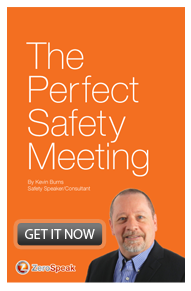3 Ways To Start Fixing Workplace Apathy In Safety
The rate of 71% of North American workers that are not actively engaged in their work should be a wake-up call to every supervisor and safety person.

Turn on the specialty TV channels like The Food Network and Home and Garden TV and you will see a steady parade of experts hosting renovation or restaurant-turnaround fix-it shows. In every one of these programs are several common denominators:
- people who don’t care about much
- people who are apathetic and don’t buy-in to their job
- people who have lost their passion for the work they do and are simply going through the motions
- people who don’t take pride in their work and think “good enough” is good enough.
It seems incredulous in this day and age with all of the measurement and monitoring technology at our disposal and with the level of instruction being better than it has ever been, that still, a half-assed effort is considered “good enough.” But it’s not just restaurants and contractors that have a problem, these problems affect every workplace.
People, overwhelmingly, are doing just enough to not get fired. The rate of 71% of North American workers are not actively engaged should be a wake-up call to every safety manager. If 7 out of 10 employees are not actively engaged in their work, then 7 out of 10 workers are not actively engaged in their safety either. Safety has become a victim of workplace apathy and a lack of personal pride.
More safety instruction, more rules, more compliance measures and more harping about it isn’t going to change an attitude of workplace apathy. Instruction and knowledge are not the problem. A personal buy-in is what is missing. Ownership and accountability are missing.
The problem gets compounded at the management level. Managers hang onto poor performers because replacing them is much more work: search, recruit, hire, train, train and train some more and you can spend up to 18 months to get a new performer up to speed of a former high performer. So safety managers adopt a “good enough” attitude in dealing with substandard performers because it easier - besides, safety managers are drowning in their own workload of investigations and trying to mitigate disasters - caused by the very attitudes and employees who take no pride in their work or their own personal safety.
When other employees see that a manager is choosing to do nothing, it creates a downward culture of “good enough.” Safety soon follows.
If you can’t seem to make people care about their work, how can you make them care about their own safety? First, you have to make them care about their work. That takes good old-fashioned management skills. Safety people who have been schooled only in safety, but not in management skills, are at a distinct disadvantage. But it doesn’t mean they can’t do it.
Here are three ways how even an unskilled supervisor or safety person can turn on a worker’s personal pride:
1Inspect, Don’t Expect - As a supervisor, you are supposed to be the eyes and ears of quality. Stop by periodically and inspect their work. If they are falling short on work quality, ask them if they think that the quality of the work is their very best. People will immediately either defend it or ask what you mean by that statement. Either way, you’ve got their attention and you get a conversation going based on the subjects of quality and effort. That’s a conversation that leads into pride in themselves and their willingness to extend themselves a higher degree of personal safety.
2Ask If They Are Feeling Rushed To Perform - sometimes a worker will rush through their work missing several quality points in an effort to keep up with higher-skilled, more experienced co-workers. The employee might actually think that you’re more concerned with quantity than quality. Although many companies offer an out-loud policy of safety-over-production, what happens on the front-lines is often times a different story. Safety always takes a back seat when the rush is on for production. Companies rush production with bonuses for early completion and pushing employees due to contractors who are waiting for completion.
3Acknowledge What They Are Doing Well - Look for points of the employee’s work that you are proud of. Start a conversation based on the things you admire about their contribution. They will begin to see their own work in a different light. But, if you can’t find anything to be proud of in your worker’s contribution, why are they still working there? Either they are the problem or you are. People will disengage from a job that offers no feedback, no accolades and no gratitude for the contribution.
Pride Is Connected To Safety
 Once you’ve identified at least one way in which the employee feels pride about their contribution, use that point as the springboard to tying it to safety. Pride in achievement and pride in self are closely linked. If you can get an employee to feel good about their contribution, they are more likely to be prepared to buy-in to safety as a way of preserving their pride. This is more than an exercise in rules and regulations. This is a conversation to bolster personal worth - which, in turn, affects willingness to wanting to keep oneself safe.
Once you’ve identified at least one way in which the employee feels pride about their contribution, use that point as the springboard to tying it to safety. Pride in achievement and pride in self are closely linked. If you can get an employee to feel good about their contribution, they are more likely to be prepared to buy-in to safety as a way of preserving their pride. This is more than an exercise in rules and regulations. This is a conversation to bolster personal worth - which, in turn, affects willingness to wanting to keep oneself safe.
Pride in safety starts with the right safety attitude.
Kevin Burns gives engaging, entertaining and inspiring speeches to front-line employees at safety meetings. He also works with supervisors and safety managers on-site or in keynote presentations at conferences. He is an expert in how to get through to people. Kevin helps organizations integrate caring for and valuing employees through their safety programs. Kevin Burns is a management consultant, safety speaker and author of "The Perfect Safety Meeting" and "Running With Scissors - 10 Reasons To Invest in Safety In Slow Times."


